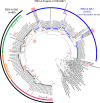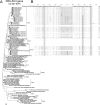Characteristics and Their Clinical Relevance of Respiratory Syncytial Virus Types and Genotypes Circulating in Northern Italy in Five Consecutive Winter Seasons
- PMID: 26047100
- PMCID: PMC4457818
- DOI: 10.1371/journal.pone.0129369
Characteristics and Their Clinical Relevance of Respiratory Syncytial Virus Types and Genotypes Circulating in Northern Italy in Five Consecutive Winter Seasons
Abstract
In order to investigate the genetic diversity and patterns of the co-circulating genotypes of respiratory syncytial virus (RSV) and their possible relationships with the severity of RSV infection, we studied all of the RSV-positive nasopharyngeal samples collected from children during five consecutive winters (2009-2010, 2010-2011, 2011-2012, 2012-2013 and 2013-2014). The RSVs were detected using the respiratory virus panel fast assay and single-tube RT-PCR, their nucleotides were sequenced, and they were tested for positive selection. Of the 165 positive samples, 131 (79.4%) carried RSV-A and 34 (20.6%) RSV-B; both groups co-circulated in all of the study periods, with RSV-A predominating in all the seasons except for winter 2010-2011, which had a predominance of RSV-B. Phylogenetic analysis of the RSV-A sequences identified genotypes NA1 and ON1, the second replacing the first during the last two years of the study period. The RSV-B belonged to genotypes BA9 and BA10. BA9 was detected in all the years of the study whereas BA only desultorily. Comparison of the subjects infected by RSV-A and RSV-B types did not reveal any significant differences, but the children infected by genotype A/NA1 more frequently had lower respiratory tract infections (p<0.0001) and required hospitalisation (p = 0.007) more often than those infected by genotype A/ON1. These findings show that RSV has complex patterns of circulation characterised by the periodical replacement of the predominant genotypes, and indicate that the circulation and pathogenic role of the different RSV strains should be investigated as each may have a different impact on the host. A knowledge of the correlations between types, genotypes and disease severity may also be important in order to be able to include the more virulent strains in future vaccines.
Conflict of interest statement
Figures


References
-
- Peret TC, Hall CB, Schnabel KC, Golub JA, Anderson LJ (1998) Circulation patterns of genetically distinct group A and B strains of human respiratory syncytial virus in a community. J Gen Virol 79: 2221–2229. - PubMed
-
- Peret TC, Hall CB, Hammond GW, Piedra PA, Storch GA, Sullender WM, et al. (2000) Circulation patterns of group A and B human respiratory syncytial virus genotypes in 5 communities in North America. J Infect Dis 181: 1891–1896. - PubMed
-
- Venter M, Madhi SA, Tiemessen CT, Schoub BD (2001) Genetic diversity and molecular epidemiology of respiratory syncytial virus over four consecutive seasons in South Africa: identification of new subgroup A and B genotypes. J Gen Virol 82: 2117–2124. - PubMed
Publication types
MeSH terms
Substances
Associated data
- Actions
- Actions
- Actions
- Actions
- Actions
- Actions
- Actions
- Actions
- Actions
- Actions
- Actions
- Actions
- Actions
- Actions
- Actions
- Actions
- Actions
- Actions
- Actions
- Actions
- Actions
- Actions
- Actions
- Actions
- Actions
- Actions
- Actions
- Actions
- Actions
- Actions
- Actions
- Actions
- Actions
- Actions
- Actions
- Actions
- Actions
- Actions
- Actions
- Actions
- Actions
- Actions
- Actions
- Actions
- Actions
- Actions
- Actions
- Actions
- Actions
- Actions
- Actions
- Actions
- Actions
- Actions
- Actions
- Actions
- Actions
- Actions
- Actions
- Actions
- Actions
- Actions
- Actions
- Actions
- Actions
- Actions
- Actions
- Actions
- Actions
- Actions
- Actions
- Actions
- Actions
- Actions
- Actions
- Actions
- Actions
- Actions
- Actions
- Actions
- Actions
- Actions
- Actions
- Actions
- Actions
- Actions
- Actions
- Actions
- Actions
- Actions
- Actions
- Actions
- Actions
- Actions
- Actions
- Actions
- Actions
- Actions
- Actions
- Actions
- Actions
- Actions
- Actions
- Actions
- Actions
- Actions
- Actions
- Actions
- Actions
- Actions
- Actions
- Actions
- Actions
- Actions
- Actions
- Actions
- Actions
- Actions
- Actions
- Actions
- Actions
- Actions
- Actions
- Actions
- Actions
- Actions
- Actions
- Actions
- Actions
- Actions
- Actions
- Actions
- Actions
- Actions
- Actions
- Actions
- Actions
- Actions
- Actions
- Actions
- Actions
- Actions
- Actions
- Actions
- Actions
- Actions
- Actions
- Actions
- Actions
- Actions
- Actions
- Actions
- Actions
- Actions
- Actions
- Actions
- Actions
- Actions
- Actions
- Actions
- Actions
- Actions
- Actions
- Actions
- Actions
LinkOut - more resources
Full Text Sources
Other Literature Sources
Medical

